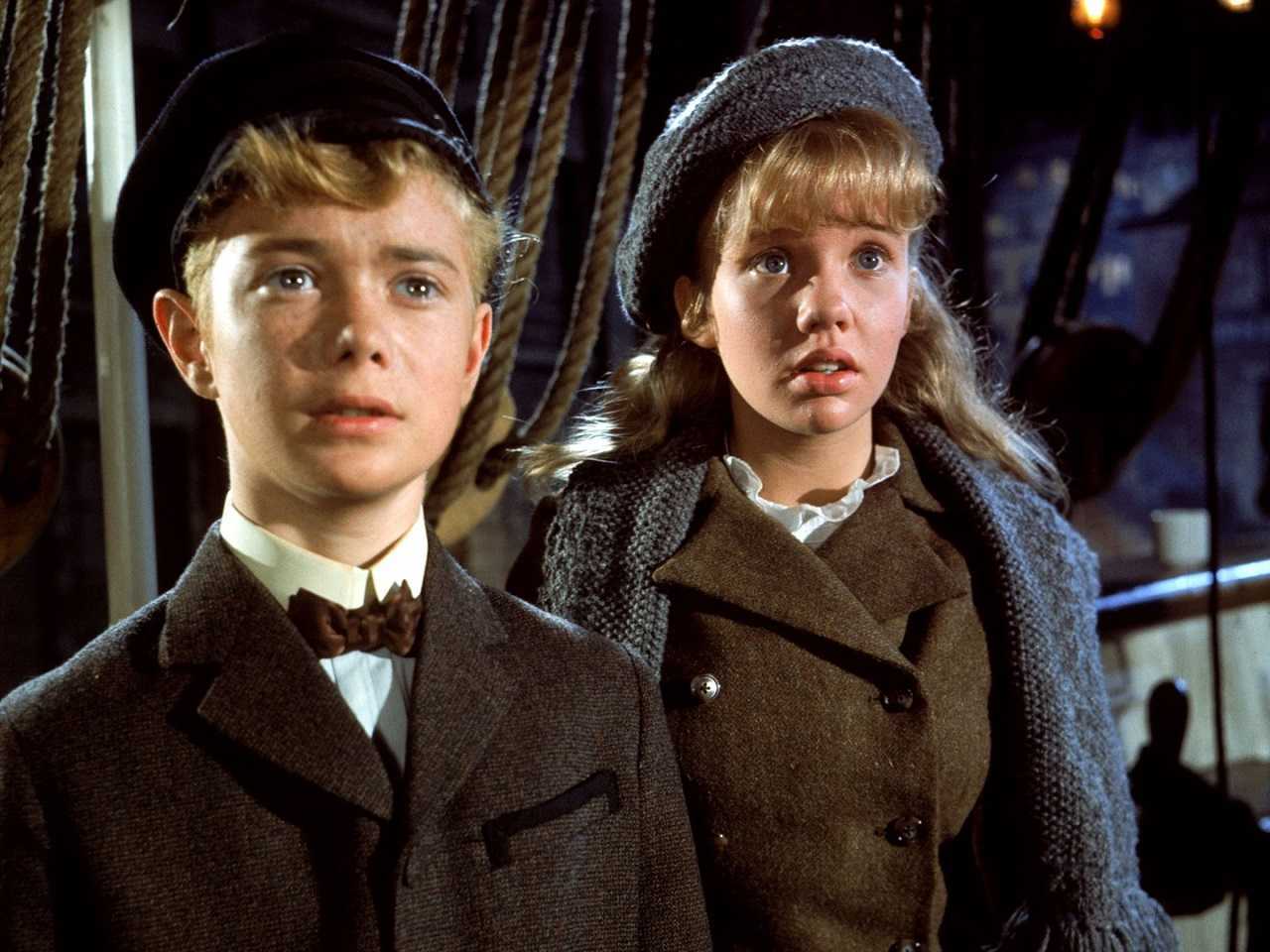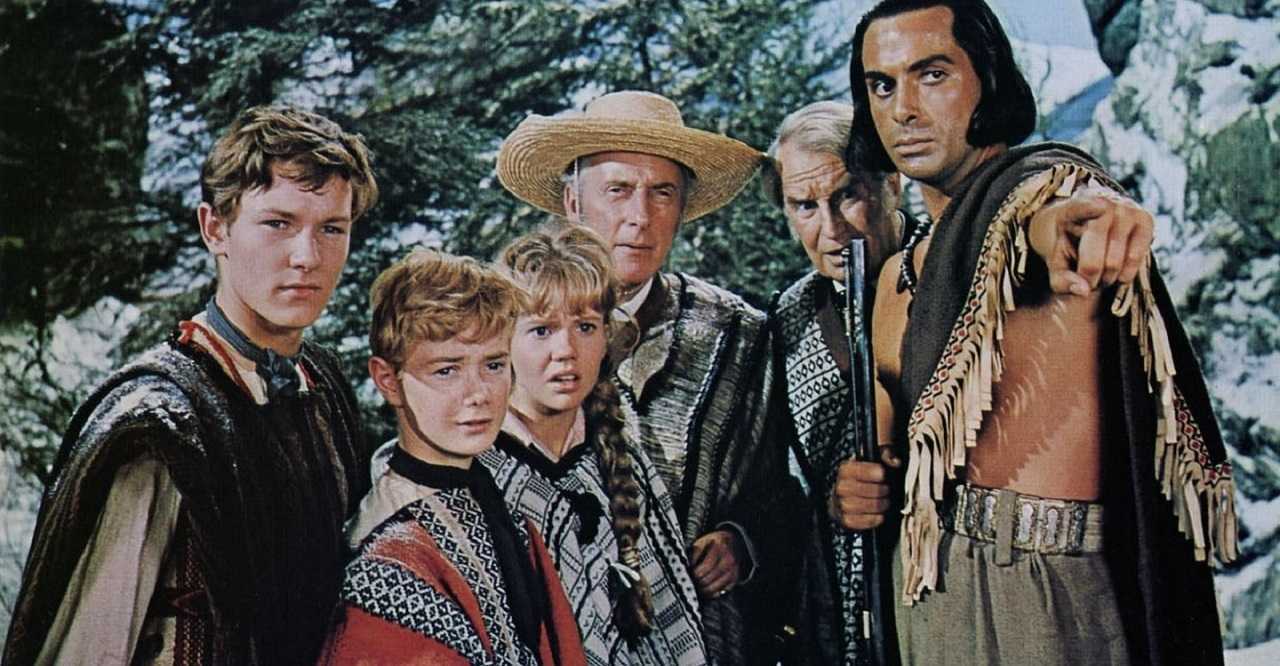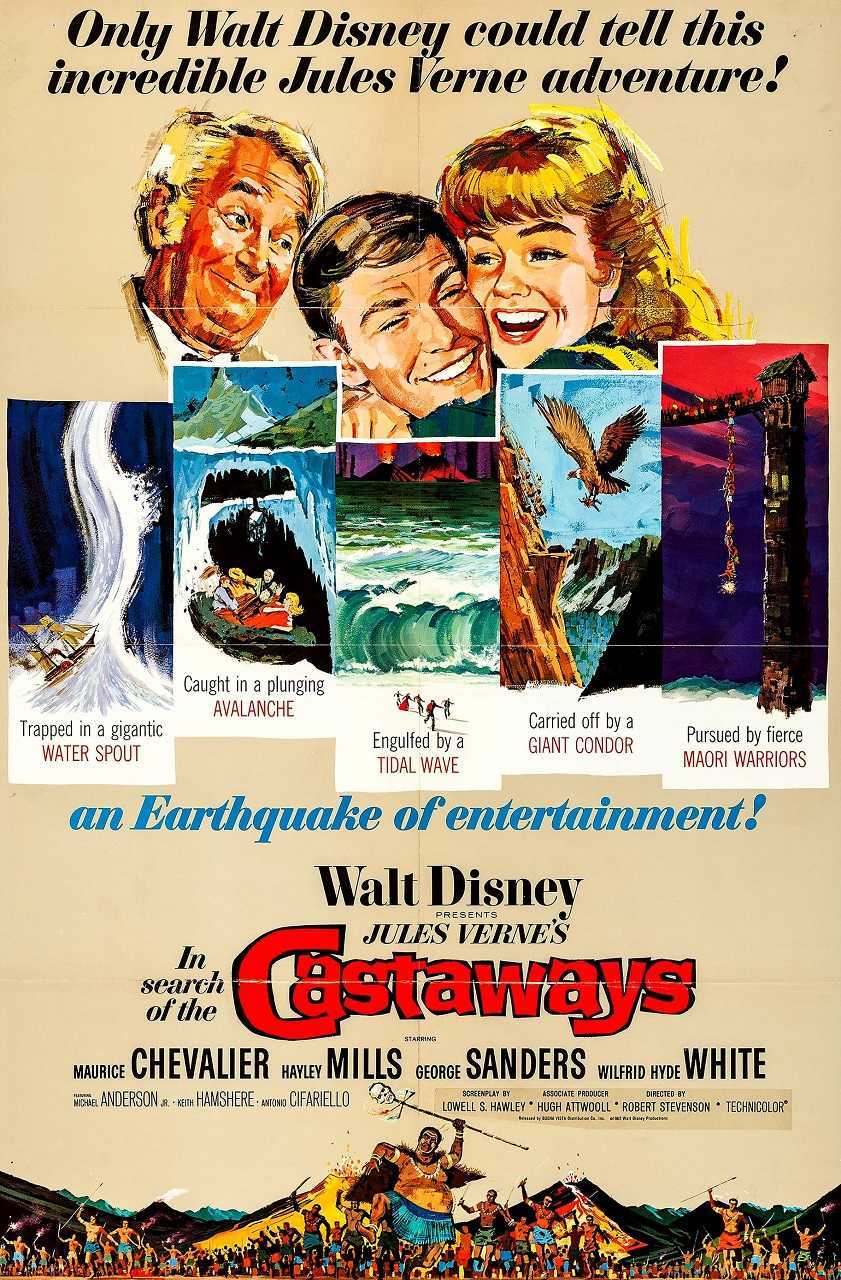USA. 1962.
Crew
Director – Robert Stevenson, Screenplay – Lowell S. Hawley, Based on the Novel Captain Grant’s Children by Jules Verne, Photography – Paul Beeson, Music – William Alwyn, Songs – Richard B. & Robert M. Sherman, Music Supervisor – Muir Mathieson, Photographic Effects – Peter Ellenshaw, Special Effects – Syd Pearson, Makeup – Harry Frampton, Art Direction – Michael Stringer. Production Company – Disney.
Cast
Hayley Mills (Mary Grant), Wilfrid Hyde White (Lord Glenarvan), Maurice Chevalier (Professor Jacques Paganel), Michael Anderson Jr (John Glenarvan), George Sanders (Thomas Ayrton), Keith Hamshire (Robert Grant), Wilfrid Brambell (Bill Gaye), Antonio Cifariello (Thalcave), Jack Gwillim (Captain Grant)
Plot
With the aid of Professor Jacques Paganel, Mary and Robert Grant smuggle aboard Perseverance II, the steam-paddle yacht owned by Lord Glenarvan. Paganel has found a message in a bottle from the children’s father, the captain of Glenarvan’s ship Britannia, which has been lost at sea. The children beg Glenarvan’s help in going to find their father. Glenarvan is eventually persuaded and they set sail. However, the message in the bottle is a fragment that only contains a latitude, the 37th Parallel, but no longitude. They set forth travelling around the 37th Parallel on an adventure that takes them to Patagonia where they face earthquakes and floods amid the Indians; to Melbourne where they are aided by Thomas Ayrton, an untrustworthy member of the Britannia’s crew; and finally to New Zealand where they must deal with Ayrton’s treachery, Maori tribes and exploding volcanoes.
In Search of the Castaways was part of a cycle of films adapted from the works of Jules Verne and H.G. Wells that came out in the late 1950s and the 1960s. The cycle was begun with Disney’s 20,000 Leagues Under the Sea (1954), which did a beautiful job of casting the whole era of scientific discovery and exploration that is the essence of Jules Verne back into a vanished era of Victorian retro-technology. Next came MGM’s Around the World in 80 Days (1956), which incredibly enough won the Academy Award for Best Picture that year, and set the tone for most of the films that followed by recasting Jules Verne’s adventure as a colourful Cinerama comic romp.
The cycle continued through adaptations of Verne’s The Fabulous World of Jules Verne (1958), From the Earth to the Moon (1958), Journey to the Center of the Earth (1959), Master of the World (1961), Mysterious Island (1961), Valley of the Dragons (1961), Five Weeks in a Balloon (1962) and The Light at the Edge of the World (1971), and of H.G. Wells’ The Time Machine (1960) and The First Men in the Moon (1964). As the cycle went on, the films became increasingly sillier and more buffoonish, ending in embarrassing results like Jules Verne’s Rocket to the Moon/Those Fantastic Flying Fools (1967) and the cartoonish Captain Nemo and the Underwater City (1969).
In Search of the Castaways, adapted from Jules Verne’s 1867 novel of the same name, which is sometimes also known as Captain Grant’s Children, is one of the more lunatic films to come out of the 1960s cycle of Jules Verne adaptations. Like all of these adaptations of Verne’s ‘voyages extraordinaires’, In Search of the Castaways ventures into exotic locales that cinematically never took place outside of Hollywood soundstages. Verne took his stories seriously but most of the films adaptations – Around the World in 80 Days, Journey to the Center of the Earth and Five Weeks in a Balloon in particular – did not, usually adding songs, comic pratfalls, buffoonish foreign caricatures and the like.

The makers of In Search of the Castaways – Disney and most of their in-house crew – have an inability to the take any of the material seriously. There is a completely silly sequence with most of the cast skidding down a mountainside on a giant plate of rock, for all the world like they are on a tobogganing holiday and guiding the rock around by shifting their weight, heading off on divergent paths when an encounter with another rock splits them in two and then sailing into the air as they reach a cliff edge, whereupon one of them is caught and carried away by a giant condor.
Or the sequence where they are stranded in a giant tree by a flood (that appears out of a nowhere in the midst of a completely bare plane!), are then menaced by a jaguar but saved when the entire tree is uprooted and carried away by a giant waterspout from which they all manage to survive miraculously unscathed. During the sequence where Keith Hamshire is lowered out of the cell window and swung across the other side of the ravine on the end of a rope, his pendulum-like swing is scored by jaunty carnival like music, which betrays a lack of belief in the seriousness of the material upon the part of the filmmakers.
Wilfrid Hyde White’s Lord Glenarvan is played as one of the bumbling upper-class British twits that occupy many of these films, while Maurice Chevalier is paired up against him as a bumbling comic Frenchman. There is a wonderful jingoism to it all of it – there is the classic moment when (in another moment of improbable absurdity), after managing to trigger off a volcanic eruption by rolling a boulder into the mouth of a volcano and sending the attacking Maoris fleeing, Maurice Chevalier shouts, “Have no fear, mademoiselle, the Maoris can run faster than the lava. Enjoy!”

Indeed, despite the lack of any traditionally Vernian fantastique elements, the wild improbability of the adventures that take place (not to mention their complete lack of resemblance to real world locales) makes In Search of the Castaways a far more genuinely fantastic film than many of the other adaptations in the Jules Verne film cycle. In fact, rather than being a betrayal of the source material, In Search of the Castaways is preposterous good fun, a good deal more so nowadays when the jolly jape of it has dated enough for one to be able to appreciate the film’s more surreal virtues.
The Jules Verne novel In Search of the Castaways/Captain Grant’s Children has been filmed several other times, although this Disney version is the only adaptation that has received any adequate English-language release. The story was previously filmed in a silent French version in 1913; a Russian film version in 1936; and a 7½ hour mini-series also made in the USSR in 1985.
British director Robert Stevenson made a number of other films for Disney that include Disney include Darby O’Gill and the Little People (1959), The Absent-Minded Professor (1961), The Misadventures of Merlin Jones (1963), Son of Flubber (1963), Mary Poppins (1964), The Monkey’s Uncle (1965), The Gnome-Mobile (1967), Blackbeard’s Ghost (1968), The Love Bug (1969), Bedknobs and Broomsticks (1971), Herbie Rides Again (1974), The Island at the Top of the World (1974) and The Shaggy D.A. (1976). Before moving to Hollywood, Stevenson also made the Boris Karloff mad scientist film The Man Who Changed His Mind (1936) and the sf film Non Stop New York (1937).
Trailer here


